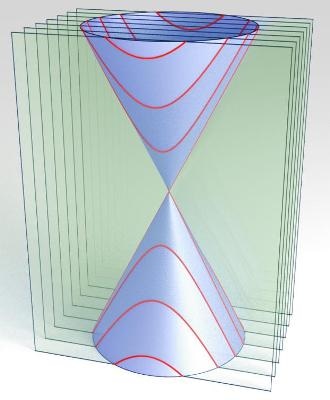May 24 2016
Quantum mechanics is the branch of physics concerned with the behavior of things at atomic scales, where things work much differently from our daily world.
 This is a dirac cone showing a typical dispersion relation (energy vs. momentum) for 2-D graphene material. Red cross-sectional lines represent quantization of the energy (and momentum) due to a finite size constriction. (Credit: B. Terrés, L. A. Chizhova, F. Libisch, J. Peiro, D. Jörger, S. Engels, A. Girschik, K. Watanabe, T. Taniguchi, S. V. Rotkin, J. Burgdörfer, C. Stampfer)
This is a dirac cone showing a typical dispersion relation (energy vs. momentum) for 2-D graphene material. Red cross-sectional lines represent quantization of the energy (and momentum) due to a finite size constriction. (Credit: B. Terrés, L. A. Chizhova, F. Libisch, J. Peiro, D. Jörger, S. Engels, A. Girschik, K. Watanabe, T. Taniguchi, S. V. Rotkin, J. Burgdörfer, C. Stampfer)
Quantization is one of the most direct signs of quantum mechanics. It leads to the discrete nature of physical characteristics at small scales, which could either be the atomic orbit’s radius or the molecular wire resistance. The most popular one, which won the Nobel Prize for Albert Einstein, is the photon energy quantization in the photoelectric effect-- the examination that many metals release electrons when illuminated with light.
Quantization takes place when a quantum particle is restricted within a tiny space. Its wave function forms a standing wave pattern, similar to the waves in a small puddle. Physicists then address about size quantization: the particle’s energy might only take those values where the standing wave’s nodal pattern matches the boundary of the system.
Quantized conductance is a remarkable result of size quantization, where the number of particles concurrently passing through a narrow passage called nanoconstriction, are discrete. The current within such a limitation is an integer multiple of the quantum of conductance.
In the latest combined theoretical and experimental work, an international team of physicists proved size quantization of charge carriers, that is, quantized conductance in nanoscale graphene samples. These conclusions have been reported in an article titled "Size quantization of Dirac fermions in graphene constrictions" in Nature Communications.
Graphene is a high-quality material of a single atomic carbon layer. When implanted in hexagonal boron nitride, graphene reveals unusual physics because of the honey comb or hexagonal symmetry of its lattice, but until now, analyzing size quantization of charge carriers in the so-called graphene nanoconstrictions has been elusive because of the high sensitivity of the electron wave to disorder.
The scientists showed quantization effects at extremely low temperatures (liquid Helium), where the effect of thermal disorder stops. This novel method of encapsulating graphene constrictions among boron nitride layers permitted remarkably clean samples, and therefore highly precise measurements.
The quantified current displays clear indications of size quantization, closely obeying hypothetical predictions at zero magnetic field. To raise the magnetic field, these structures progressively develop into the Landau levels of the quantum Hall effect.
The high sensitivity of this transition to scattering at the constriction edges reveals indispensable details about the role of edge scattering in future graphene nanoelectronic devices.
Slava V. Rotkin, Professor of Physics and Materials Science & Engineering, Lehigh University